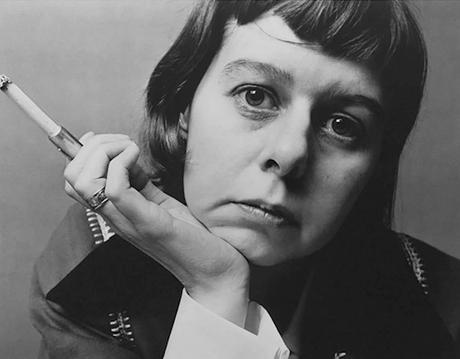Book Review by Sylvia D: The Haunted Boy brings together three short stories, A Domestic Dilemma (first published in Mademoiselle in 1950), The Sojourner (first published in the New York Post in 1951) and The Haunted Boy (published posthumously in 1955). All three stories explore the theme of loss; loss of a wife to alcoholism, loss of a marriage, feared loss of a mother, but it is love that can make that loss easier to bear.
 Carson McCullers
Carson McCullers
None of the stories is very long and they can be read very quickly. However, they repay a second reading to appreciate fully the elegance of McCullers’ writing, ‘The twilight border between sleep and waking was a Roman one this morning; splashing fountains and arched, narrow streets, the golden lavish city of blossoms and age-soft stone’ (The Sojourner).’ Equally, the way McCullers can create a feeling of foreboding is very marked. Hugh, the haunted boy, comes home from school with his friend to an unexpectedly empty house. The last time he had come home to a seemingly empty house, he had made a shocking and, for a child, an incomprehensible discovery.
It was then, in the unanswering silence as they stood in the empty, wax-floored hall, that Hugh felt there was something wrong. There was no fire in the grate of the sitting room, and since he was used to the flicker of firelight during the cold months, the room on this first warm day seemed strangely naked and cheerless. Hugh shivered.
To reveal why Hugh was so fearful would spoil the story for those who haven’t read it, but McCullers gets across very quickly the young boy’s terror by devices such as contrasting the warmth of the day with the ‘naked and cheerless’ room and by introducing a friend, John, who has no such qualms and makes sensible suggestions as to why Hugh’s mother might not be there. It is only gradually that John comes to realize Hugh is so upset but does not understand why.
Similarly, in The Sojourner, John Ferris, who leads a nomadic life, suddenly spots his ex-wife, Elizabeth, when he is in New York for his father’s funeral. Already in a state of dismay over his reaction to his father’s death, when he sees her, ‘his body jerked suddenly. . . ’ and ‘He could not understand the wild quiver of his heart, nor the following sense of recklessness and grace that lingered after she was gone.’ The device of contrast appears again, ‘his clouded heart was oddly dissonant with the sunny, candid, autumn day’. When Ferris, perhaps unwisely, accepts Elizabeth’s invite to dinner, his aloneness and transience are contrasted with the warmth and closeness of his wife’s new family and her exquisite piano playing. By the time Ferris has reached his new lover’s flat in Paris, he has discovered the ‘disorder of his life’ and is in a state of terror.
Again, in A Domestic Crisis, foreboding is presaged by Martin knowing that when he gets home he will be faced by the alcoholism of his wife but dismayed at the bleakness of their yard and the way their ‘too white and new’ cottage looks ‘naked’; he finds his ‘lovely children’ have got out the Christmas decorations and the Christmas tree coloured lights ‘glowed with out-of-season festivity . . .’
In all three stories this sense of fear, of foreboding and of terror are assuaged by the power of love but, if you want to know how, you will have to read them for yourself. I thoroughly enjoyed reading them and I’m not usually a short story fan. I was struck by how powerfully McCullers was able to create such powerful emotions and to draw her characters so strongly in so few words.
